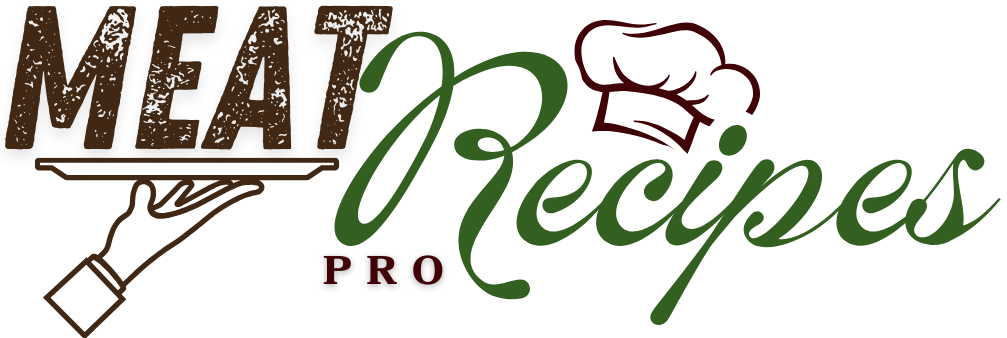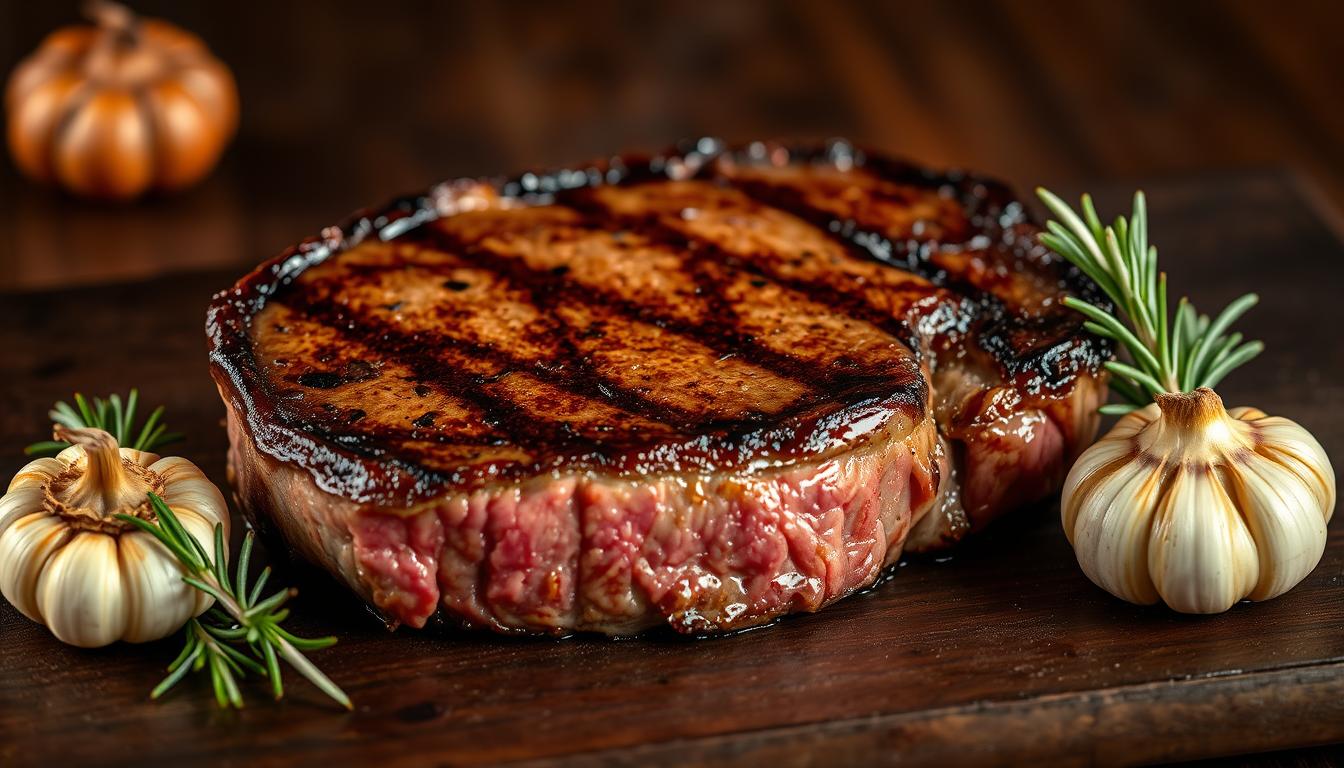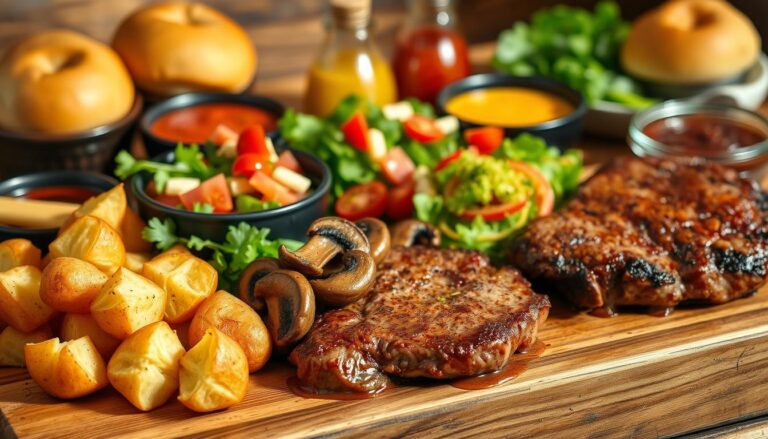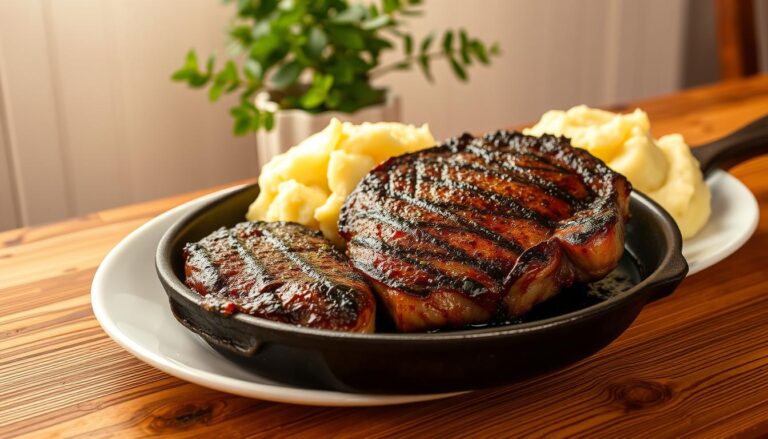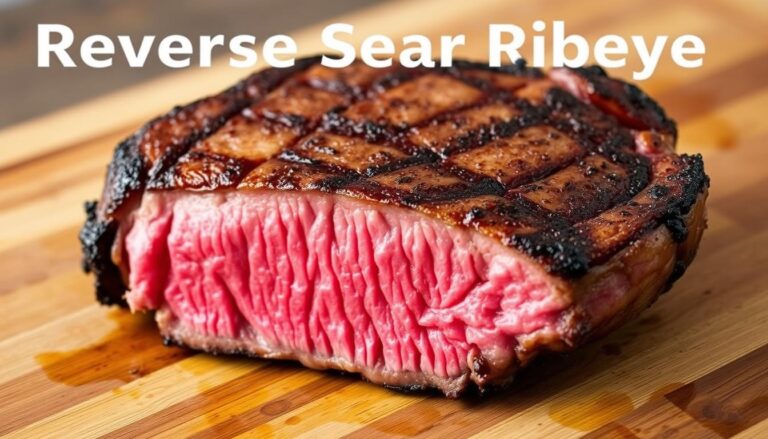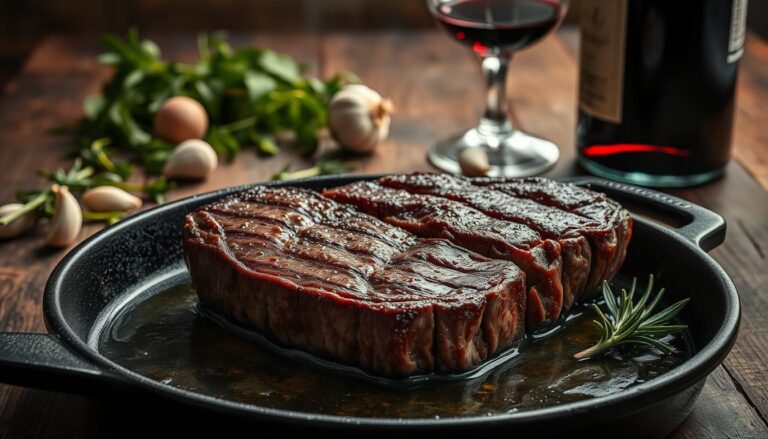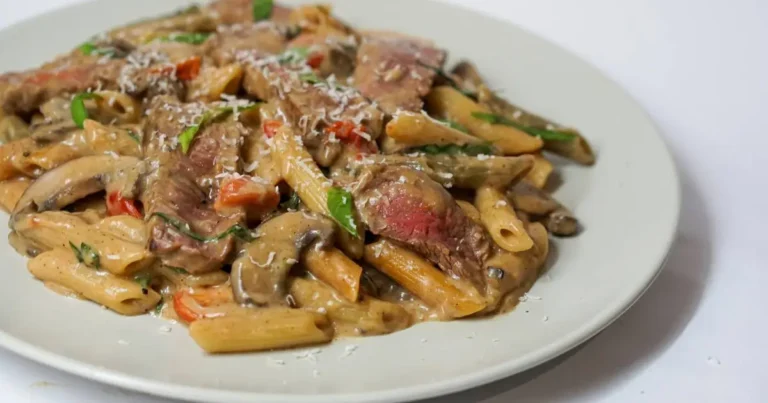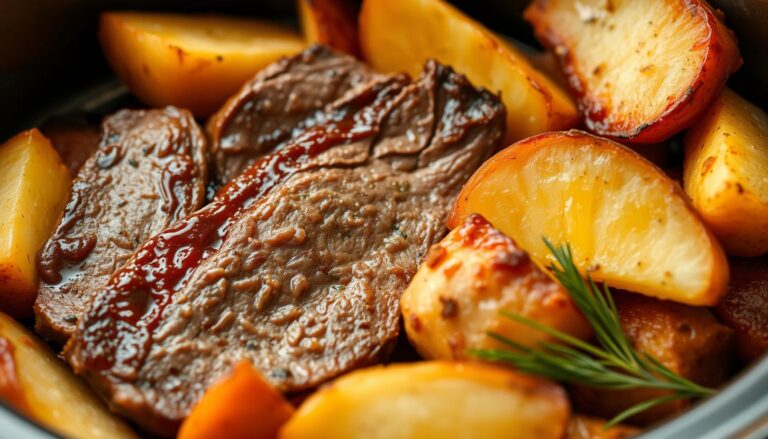Discover the Delmonico Steak: A Culinary Delight
You may remember a dinner that felt like more than a meal — that warm, full bite that stayed with you. This introduction invites you into a short, practical guide to help with your next butcher chat and your dinner choice.
Today you’ll learn how this cut compares to a ribeye, why price often favors one over the other, and how origin — from chuck versus rib — changes tenderness and flavor.
Expect clear tips on thickness, cooking tips for medium-rare, and how marbling shapes a buttery versus bold bite. This section sets up the rest of the content so you can choose with confidence.
Ready to dig in? The next parts trace New York roots, butcher labels, and quick cooking methods for weeknight wins.
Table of Contents
What is a Delmonico steak? Your quick definition and why it’s confusing
Regional butchery habits mean a single name can point to several distinct beef portions. That simple fact explains most of the confusion you face at the meat counter.
Think of the label more as a category than a single cut. At least nine different cuts sell under this name across the United States. Your local butcher or grocer often decides which section of the cow gets that tag.
A flexible name for several premium options
The term can refer to chuck-eye slices, bone-in or boneless rib portions, or top loin pieces that resemble a New York strip. That variety means two items with the same label can look and cook differently.
Common placements on the cow
You’ll find versions from the chuck area near the ribeye, from the rib section cow, and from short loin or top loin. Ask which section cow the cut comes from to predict tenderness and fat content.
Bone-in versus boneless today
Butchers label both bone-in and boneless pieces as options. The bone can add flavor and change cooking time, while boneless portions often cook faster and feel leaner in your mouth.
“The name remains unstandardized; local practice determines the final cut.”
| Source | Typical feel | Best use |
|---|---|---|
| Chuck-eye | Beefy, good value | Quick sear, weeknight recipe |
| Rib section | Heavily marbled, buttery | High-heat sear, special meals |
| Short loin / top loin | Firm, strip-style | Grill or pan-sear for consistent slices |
- Tip: Ask, “Is this from the chuck or short loin?” to learn the real cut.
- Note: The main difference with ribeye is origin—ribeye always comes from the rib.
Origins at Delmonico’s Restaurant in New York: from 1800s icon to today
Trace the name back to one New York dining room that changed American menus in the 1800s.
Delmonico’s restaurant in mid-1800s Manhattan pioneered à la carte service. Guests could finally choose dishes by name. That choice helped one menu item gain fame and a loose culinary identity.
The likely original cut was a dry-aged, boneless prime top loin known for deep flavor. Historic sources point to top sirloin rather than a rib section. That old practice prized aged beef and firm texture.
Today you see different takes. The current Delmonico’s in New York lists a boneless ribeye as its signature. Elsewhere, like Emeril’s restaurants, the name tags a bone-in rib cut. These variations show why the label spans several cuts across the cow.
“The restaurant legacy explains why the same name can mean different portions in different places.”
| Era | Typical cut | Key trait |
|---|---|---|
| Mid-1800s | Dry-aged boneless top loin | Deep, beefy flavor from aging |
| Modern NYC | Boneless ribeye | Marbled, tender, restaurant favorite |
| Emeril’s version | Bone-in ribeye | Rich flavor, bone adds depth |
- Tip: Ask which section the cut comes from to match your plate to tradition.
Where the steak is cut from: chuck eye, rib section, short loin, and beyond
One name can span the chuck, rib, and loin; each area gives a distinct eating experience. Knowing the source helps you predict fat, flavor, and cooking time before you buy.
Chuck-eye “Delmonico”: proximity to ribeye and value appeal
The common definition calls out the first 3-inch boneless chuck eye where it meets the rib. That small run yields just two such pieces per carcass, one per side.
Why it matters: This cut chuck offers rib-like flavor at a lower price and often feels very beefy on the plate.
Rib and ribeye variants: marbling and buttery richness
When the cut comes from the rib or the chuck-end of the ribeye, expect heavier marbling. That fat content creates a butter-soft mouthfeel when cooked over high heat.
Ask whether the piece comes from the rib section cow to confirm how rich the bites will be.
Short loin/top loin options: New York strip-style choices
Top loin or short loin interpretations yield a New York strip-style piece. These are often leaner than rib cuts but still tender with a firmer bite.
At the counter, ask clear questions: is this chuck eye, cut rib, or top loin? Also confirm bone-in or boneless so you can plan cooking and resting time.
- You’ll connect the section cow to expected fat content and mouthfeel.
- Regional naming means the same label can span several areas of the carcass.
- Use simple anatomy terms so your butcher knows the exact cuts you want.
Delmonico vs. Ribeye: cuts, fat content, marbling, and beefy flavor
Use origin, marbling, and price to decide which cut fits your plate tonight.
Cut origin snapshot
ribeye always comes from the rib section. That single origin explains much about its texture and fat behavior.
The delmonico steak label varies by butcher and can come from chuck, rib, or loin. This variation drives the real eating experience.
Fat, marbling, and flavor
ribeye shows heavy marbling that melts into plush, buttery bites. In contrast, delmonico steak often reads leaner with a more intense beef flavor and firmer chew when from chuck or loin.
Both cuts shine at medium-rare to preserve juiciness and texture.
Price, availability, and cooking
Expect price gaps: delmonico often runs $5–$10 per pound, while ribeye commonly lists $15+ per pound. Choose based on budget and the meal’s intent.
| Feature | ribeye | delmonico steak |
|---|---|---|
| Origin | Rib section | Chuck, rib, or loin |
| Marbling | Heavy, buttery | Balanced to lean |
| Flavor & texture | Rich, tender | Beefy, firmer |
| Best cooking methods | High heat sear, grill | Versatile; tenderize if chuck |
- Choice: For decadent, pick ribeye; for value and beefy flavor, pick delmonico steak.
Appearance and texture: thickness, weight, and mouthfeel you can expect
A quick glance at size and marbling will predict whether your bite turns plush or firmly beefy.
You’ll often find a delmonico steak cut thicker and heavier than many ribeye portions. Expect about 1 ¾–2 inches and near one pound for many pieces. By contrast, ribeye servings often measure around 1 ½ inches and run closer to half a pound.
Look for marbling differences. Ribeye shows a dense web of intramuscular fat that yields a buttery mouthfeel. The delmonico label usually displays fewer, thinner fat lines, which gives more chew and a more focused, intense flavor.
Thickness changes your cooking plan. Thicker cuts benefit from a two-zone grill or quick oven finish to reach edge-to-edge pink without overcooking the surface. Also note that cuts from the rib side on either one side of the carcass often present extra marbling and tenderness, regardless of the package label.
“Thickness, weight, and fat content set expectations for doneness and mouthfeel.”
- Thickness and weight predict cook time and serving size.
- Marbling controls plushness; leaner lines boost beefy character.
- Plan heat zones for thicker cuts to preserve texture.
Cooking methods that shine: grill, cast-iron sear, and air fryer
For busy nights pick the air fryer; for dramatic crust use a hot grill or cast iron pan.
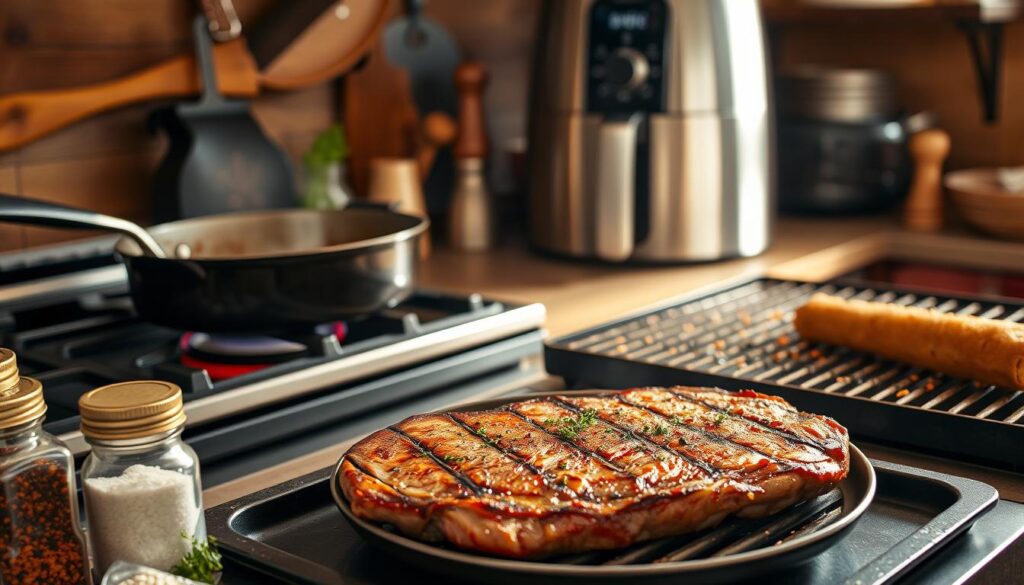
Best approach for versatile cuts
Season boldly with olive oil, salt, pepper, and garlic powder. If the piece comes from chuck, try a quick dry brine or gentle tenderize before high-heat searing.
Air fryer recipe and timing
Preheat to 400°F. Cook 8–10 minutes, flip once at the halfway mark, then rest 5 minutes. This option gives a fast, reliable medium-rare with minimal cleanup.
Grill and cast-iron for ribeye
Use very high heat to render marbling and build a deep crust. Grill or pan-sear about 4–5 minutes per side for medium-rare, then rest 5–7 minutes to lock juices.
Target doneness
Medium-rare preserves tenderness and juiciness for both cuts. Adjust minutes slightly for thickness and personal preference.
| Method | Time | Key benefit |
|---|---|---|
| Air fryer | 8–10 minutes | Fast, even cook, low cleanup |
| Cast-iron | 4–5 minutes/side | Restaurant crust, strong sear |
| Grill (two-zone) | 4–5 minutes/side + finish | Char, smoke, control fat flare-ups |
“Let the meat rest; that five minutes saves most of the juices.”
Buying smart: grades, thickness, and price per pound today
Smart buying starts with a quick check of price per pound and visible marbling. Compare the tags so you know whether the piece fits your meal plan and budget today.
Price guide: Expect delmonico steak near $5–$10 per pound versus ribeye at $15+ per pound. That gap explains why you’ll pick one for weeknight meals and the other for special dinners.
Look at marbling and fat. Heavy marbling gives plush flavor for ribeye. Leaner lines give focused beef flavor and chew for many delmonico cuts.
How to spot value in chuck-eye and rib sections
- Seek chuck eye when you want rib-like flavor at lower cost; it’s a strong value option.
- Ask for 1½–2 inches thickness so your steak cut cooks evenly and hits target doneness.
- Check beef grades and visible marbling to balance tenderness and price.
- Confirm the area the piece comes from—chuck, rib, or loin—and whether it’s bone-in or boneless.
- Reserve ribeye steaks for special meals; pick delmonico steak as an everyday choice.
Regional names and butcher shop talk: how to order the cut you want
A short talk with your butcher saves surprises. Use clear anatomy terms so you get texture and flavor that match your plan.
Ask by anatomy: ribeye, top loin, or top sirloin references
Begin by asking whether the piece comes from the rib, short loin, or top sirloin. That one question pins down tenderness and fat.
Say: “Is this from the ribeye, top loin, or top sirloin?” That phrasing helps you avoid regional label confusion.

Recognizing market names: club steak, shell steak, Kansas City/NY strip
Market names often map to the same anatomy. Club or shell usually means top loin. Kansas City and New York strip point to the same loin family. Some shops use the historic delmonico restaurant tag for ribeye or for top sirloin.
- Tip: Confirm whether the item is bone-in or boneless and the thickness.
- Tip: Ask which section or area of the carcass it came from.
| Market name | Anatomy | Cooking cue |
|---|---|---|
| Club / Shell | Top loin | Firm bite, great for grilling |
| New York / Kansas City | Short loin / strip | Even slices, medium-rare friendly |
| Ribeye / rib | Rib section | Heavy marbling, sear hot |
“Ask anatomy first; names vary by shop.”
Conclusion
Armed with clear cues, you’ll avoid surprises and get the bite you want.
This short guide helps you pick between a richly marbled ribeye and a value-forward delmonico steak that often delivers bold, beefy flavor.
You can follow simple cooking times: sear ribeye about 4–5 minutes per side for medium-rare and rest 5–7 minutes. For faster results, try the air fryer at 400°F for 8–10 minutes, then rest 5 minutes.
Ask butcher questions by naming rib, loin, or chuck so you land the exact cuts beef option you want. Use these recipes and timing tips the next time you shop and cook.
